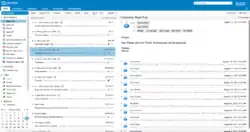Zimbra
Zimbra Collaboration, formerly known as the Zimbra Collaboration Suite (ZCS) before 2019, is a collaborative software suite that includes an email server and a web client.
 | |
| Developer(s) | Synacor |
|---|---|
| Initial release | July 26, 2005 |
| Stable release | 8.8.15[1]
/ July 22, 2019 |
| Repository | |
| Platform | Linux |
| Type | Collaborative software |
| License | Zimbra licensing |
| Website | www |
Zimbra was initially developed by LiquidSys, which changed their name to Zimbra, Inc. on 26 July 2005.[2] The Zimbra Collaboration Suite was first released in 2005. The company was subsequently purchased by Yahoo! on September 17, 2007,[3] and later sold to VMware on January 12, 2010.[4] In July 2013, it was sold by VMware to Telligent Systems[5] which changed its name to Zimbra, Inc. in September 2013.[6] It was then acquired by Synacor on 18 August 2015.[7]
According to former Zimbra President and CTO Scott Dietzen, the name for Zimbra is derived from the song "I Zimbra" by Talking Heads.[8]
Edition
The software consists of both client and server components, and at one time also offered a desktop email client, called Zimbra Desktop. Two versions of Zimbra are available: an open-source version, and a commercially supported version ("Network Edition") with closed-source components such as a proprietary Messaging Application Programming Interface connector to Outlook for calendar and contact synchronisation.[9]
The now discontinued Zimbra Desktop was a full-featured free desktop email client.[10] Development was discontinued under VMware's stewardship in 2013 but was restarted in February 2014, but was ended again by 2019. The web client featured an HTML5 offline mode starting with version 8.5.[11]
The Zimbra Web Client is a full-featured collaboration suite that supports email and group calendars. At one time it featured document-sharing using an Ajax web interface that enabled tool tips, drag-and-drop items, and right-click menus in the UI. Today it has document sharing, chat, and videoconferencing. Also included are advanced searching capabilities and date relations, online document authoring, "Zimlet" mashups, and a full administration UI. It is written using the Zimbra Ajax Toolkit.[12]
The Zimbra Server uses several open source projects (see the section, Included open source projects). It exposes a SOAP application programming interface to all its functionality and is also an IMAP and POP3 server. The server runs on many Linux distributions.[13] It also can be run on a Windows Server, using a virtual machine and using container technology. It supports CalDAV, CardDAV and SMTP for messaging, LDAP for directory services, and Microsoft Active Directory (AD). Zimbra uses Postfix for its MTA functionality. It includes technology from ClamAV, SpamAssassin and DSPAM for anti-malware features and S/MIME for email signing and encryption. OS X Server support was dropped with version ZCS 7.0.
Zimbra can synchronize mail, contacts, and calendar items with open-source mail clients such as Mozilla Thunderbird and Evolution and also with proprietary clients such as Microsoft Outlook and Apple Mail, either through proprietary connectors or using the ActiveSync protocol,[14] both available exclusively in the commercially supported version. Zimbra also provides native two-way sync to many mobile devices.[9]
Software license
The closed source variant Network edition is distributed under the Zimbra Network Edition EULA.
Starting with version 8.5 the Zimbra source code is available under the terms of the GNU General Public License version 2 (backend) and the Common Public Attribution License version 1 (frontend).[15]
Previous versions were released under the Zimbra Public License (ZPL). The Free Software Foundation accepts the license as being a free software license and refers to it as being identical to the Yahoo! Public License with the exception that Zimbra, Inc. provides the license, rather than Yahoo!.[16]
Included open source projects
The Zimbra Server uses open source projects such as:[17]
- Postfix
- MariaDB (since version 8.5)
- OpenDKIM (since version 8.0)
- OpenLDAP
- Jetty (since version 5)
- Lucene
- ClamAV
- SpamAssassin
- Amavis (amavisd-new)
- DSPAM (deprecated starting 8.7)
- Aspell
- nginx (since 5.0)
- ØMQ (since 8.0)
It previously used:
- MySQL (last used in version 8.0)
- Apache Tomcat (last used in version 4.5)
- Perdition mail retrieval proxy (until 4.5)
References
- "Zimbra Releases - Zimbra :: Tech Center". zimbra.com. Retrieved 15 October 2019.
- "Patent US20090100073 - System and method for enabling an external-system view of email attachments". google.je. Retrieved 22 February 2016.
- "Yahoo! Inc. - Company Timeline". Wayback Machine. 2008-07-13. Archived from the original on 2008-07-13. Retrieved 2017-02-13.CS1 maint: bot: original URL status unknown (link)
- Vance, Ashlee (2010-01-13). "VMware Gently Nudges Microsoft with a Zimbra". New York Times Bits Blog. Retrieved 2010-05-30.
- Henry, Tiffany (2013-07-15). "Telligent Acquires Zimbra from VMware". Telligent. Retrieved 2013-07-15.
- Henry, Tiffany (2013-09-25). "Zimbra Unveils Integrated Team, Culture and Vision for People-Centered Collaboration at User Group Conference". Telligent. Retrieved 2013-12-15.
- "Synacor Agrees to Acquire Zimbra, a Leading Provider of Open Source Based Email and Messaging Software". Global News Wire. Retrieved 18 August 2015.
- Dietzen, Scott (2005-09-12). "So what's a Zimbra?". Zimbra Blog. Retrieved 2013-01-17.
- "Zimbra Compatibility with Other Desktop Clients". VMware Zimbra Official Web Site. VMware Zimbra. Retrieved 8 January 2013.
- "Zimbra Desktop". VMware Zimbra Official Web Site. VMware Zimbra. Retrieved 8 January 2013.
- "Zimbra Collaboration 8.5: Anytime, Anywhere, Any Device". Zimbra Blog. Zimbra. Retrieved 5 March 2015.
- "Zimbra Documentation for the Zimbra Web Client". VMware Zimbra Official Web Site. VMware Zimbra. Retrieved 8 January 2013.
- "Zimbra Open Source". Zimbra Official Web Site. Zimbra. Retrieved 8 January 2013.
- "Exchange ActiveSync(EAS) Outlook 2013". Zimbra Official Wiki. Zimbra. Retrieved 5 March 2015.
- "OSI Licenses for Zimbra Collaboration Open Source Edition". Jon Dybik. Retrieved 2014-06-05.
- "Various Licenses and Comments about Them". Free Software Foundation. Retrieved 2011-07-08.
- "Zimbra Components". Retrieved 16 July 2014.